Camellia japonica ‘Odoratissima’
Beautiful blooms in an evergreen garden, the Camellia Japonica Odoratissima produces a rich display of dense foliage and large, slightly fragrant, rose pink, semi double to peony blooms. It is a hardy, long living plant that likes acidic soil. It looks great in a feature pot and also makes a wonderful hedge.
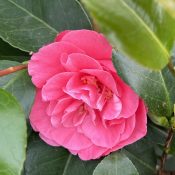
Cupressocyparis leylandii
Despite its bad reputation the “Leyland Cypress” is a very useful evergreen hedging and screening plant, having the fastest growth rate of up to 90cm a year. If kept to a maintainable height by cutting at least once a year it is a very economical screening solution. Regular clipping of the mid green, spray like citrus scented foliage, in midsummer and autumn, can make this a superb, dense, formal garden hedge, ideal as a windbreak and for noise reduction on any non-
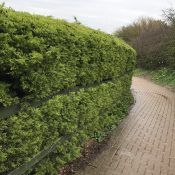

Elaeagnus ‘Coastal Gold’
Large, bushy, evergreen, quick growing shrub with large dark green glossy leaves with striking yellow centres. Small, beautifully fragrant silver flowers in autumn. Ideal for hedges up to 3 meters. Hardy and particularly suited to coastal areas in sun or partial shade.
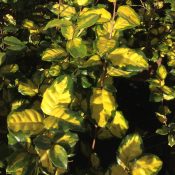
Elaeagnus ebbingei
The “Oleaster” is a tough evergreen shrub with green leaves that have small silver spots and silvery-
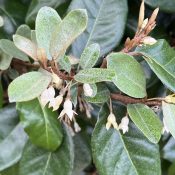
Elaeagnus ‘Limelight’
This “Oleaster” variety is strong growing variegated evergreen shrub with broad and leathery dark green leaves with striking lime green to yellow variegation at the centre. It is fully hardy and will tolerate dry soil, growing in full sun or partial shade. Its growth is average to fast and it has small deliciously scented creamy white flowers in the autumn followed, occasionally by orange fruits in the spring. Ideal for hedges up to 2.5 meters. Hardy and particularly suited to coastal exposure.
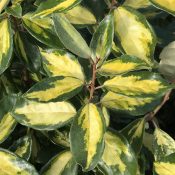
Escallonia macrantha Rubra ‘Crimson Spire’
This is a Cornish raised cultivar of the native Chilean “Gum Box”, and one of the fastest growing broadleaf evergreen hedging plants. With dark-

Escallonia iveyii
This is a Cornish raised cultivar of the native Chilean “Gum Box”. It is a vigorous medium-
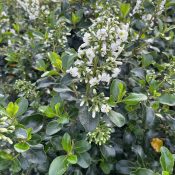
Euonymus japonicus
The “Japanese Spindle” is an evergreen dense, bushy shrub or erect small tree which will form an excellent evergreen hedge especially in exposed conditions. Narrowly oval, toothed, leathery leaves to 6cm long. Unpruned will grow to 4 metres.

Euonymus japonicus ‘Aureopictus’
This “Japanese Spindle” cultivar is a dense, bushy, evergreen shrub with oval, glossy, dark green leaves with a central golden mark. Small green flowers bloom in summer and are occasionally followed by fruit in autumn. It will form a bright and colourful low (up to 1.2m) evergreen hedge in sun or partial shade. Prefers well drained soil. Trim in April.
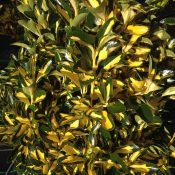
Euonymus japonicus ‘Bravo’
This “Japanese Spindle” cultivar is an evergreen dense, bushy shrub with narrowly oval, toothed, leathery green 6 cm long leaves margined with creamy yellow, fading to cream. It will form a bright and colourful low (up to 1.5m) evergreen hedge in sun or partial shade. Prefers well drained soil. Trim in April.
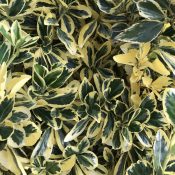
Euonymus japonicus ‘Green Rocket’
Compact, upright, evergreen shrub with tiny, tightly packed dark green leaves, contrasting with the paler new growth. Prefers well drained soil and full sun/partial shade. Suitable for hedging or as a specimen in a container. Perfectly suitable for seaside gardens.
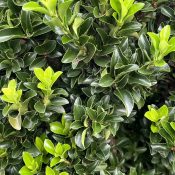
Griselinia littoralis
The “Kapuka” is a broadleaved evergreen native to New Zealand. It is well-
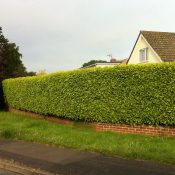
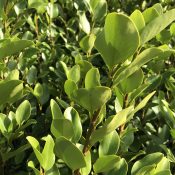
Griselinia littoralis ‘Green Horizon’
This new “Kapuka” hybrid is similar to the standard Griselinia littoralis, but with deeper green and oval glossy foliage. It is a fast growing evergreen, hardy to at least -10°C. It will withstand salt laden winds but not right on the seafront. Upright growing, this variety forms a dense hedge that can be trimmed to 1.5 meters or more if required (up to 5m) and a width of only 60cm so it won’t take up a large part of your garden.
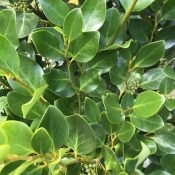
Griselinia littoralis ‘Variegata’
This “Kapuka” hybrid is a slower growing Griselinia with attractive irregularly margined cream leaves streaked with grey and green. It grows about 20cm a year, making it very suitable for smaller sized hedges of 1 to 2 meters tall. It will withstand salt laden winds but not right on the seafront.
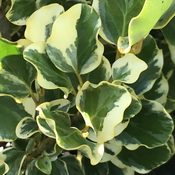
Ilex altaclerensis ‘Golden King’
Bushy female “Holly”. Young branches are green with purplish flush. Has large oblong to oval sometimes spiny, dark green leaves splashed with grey-green in the centre with bright yellow margin that turns cream on older leaves. Red berries in autumn and winter. Height up to 6 meters if left unpruned. Ideal subject for an attractive evergreen hedge.
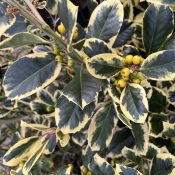
Ilex altaclerensis ‘Hodginsii’
The “Highclere Holly” has large dark green only slightly spiny leaves on stout purplish stems, which show up the small white flowers in late spring. It makes an excellent, slow growing (15 to 20 cm per year) evergreen hedge or less formal screen which is best pruned in late summer or left un-

Ilex altaclerensis ‘Lawsoniana’
Compact evergreen shrub or small tree about 6m tall, with yellow-streaked green stems bearing broad, almost spineless dark green leaves to 11cm long, splashed with yellow in the centre. Small white flowers in late spring are followed by reddish-brown berries ripening to red during autumn.
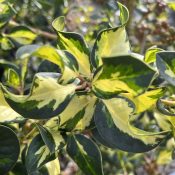
Ilex altaclerensis ‘Wilsonii’
A rare variety of Highclere holly. It bears 5 to 7cm long, oval to oblong, deep-green glossy leaves that are mildly spiny when young and lose spines as the plant grows taller than 1m, then new leaves become mostly entire with just one sharp tip. It is a female variety that bears profusion of large, vivid red berries if a male pollinator is nearby.
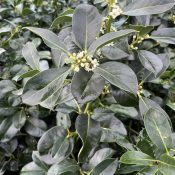
Ilex aquifolium ‘Argentea Marginata’
This “Holly” has bright silver margined dark green prickly foliage which is purplish-
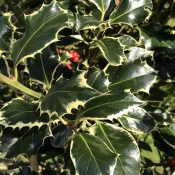
Ilex crenata ‘Convexa’
The handsome “Japanese holly” is a tiny dark, glossy, green leaved and slow growing hardy evergreen. It will grow to about 4 metres tall eventually if un-
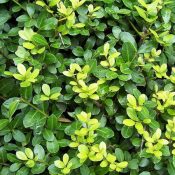
Ilex maximowicziana ‘Kanehirae’
This “Japanese holly” is the best buxus substitute with its beautiful dark-
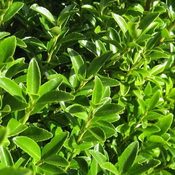
Laurus nobilis
“Bay Laurel” is one of the oldest shrubs in cultivation, it originates from the Mediterranean, is also known as Sweet Bay and of course it is the source of the bay leaves used fresh or dried in cooking. Its aromatic glossy dark green leaves make it a beautiful plant for hedging, topiary or as a specimen. It is fully evergreen, likes a fertile, moist well drained soil and sun or partial shade. Hedges up to 3 meters require a light trim in spring or summer to keep them in shape. Unpruned can grow to 6m. Can partially defoliate in positions exposed to cold winds during winter.
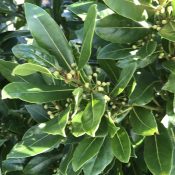
Ligustrum ovalifolium
“Privet” is a widely grown evergreen/semi evergreen, meaning it’s generally evergreen but may lose some or all of its leaves in very hard winters but shoots right back again in spring! Rich green leaves form creamy white flowers in July, attracting butterflies and birds, but are generally clipped away. It’s almost indestructible once established and resistant to pollution – a very popular choice in urban and suburban gardens. Fast growing (approx. 30cm per year), trim a couple of times during summer to form a dense, formal garden hedge 1 to 3 meters tall. Grows well virtually anywhere except wet sites. Suitable for coastal situations although it may defoliate a bit in winter near the coast.
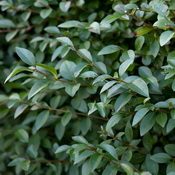
Ligustrum japonicum ‘Texanum’
The “Waxleaf Privet” is an interesting cultivar of Japanese privet, it is smaller than the species with dark-
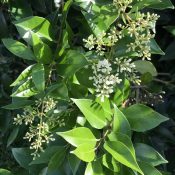
Ligustrum lucidum
The “Chinese Privet” is the most common evergreen tree in its native Hupeh province. It has glossy oval pointed dark green leaves and large bunches of white flowers in August and September. Un-pruned, it makes a handsome screening tree of up to 6 meters; clipped into a hedge can be maintained at 2 to 3 meters. This species will withstand drought, but grows best if irrigated during prolonged dry spells. All Privet begin forming the buds for next year’s flowers soon after the current season’s blossoms fade. To avoid shearing off the young buds, prune the plants right after they flower to control the height and prevent the plant from overreaching its bounds. Tolerates severe pruning.
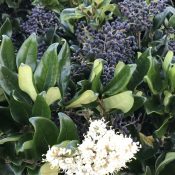
Osmanthus burkwoodii
Osmanthus x burkwoodii is a lovely dense dark green evergreen hedging plant with the bonus of fragrant jasmine-
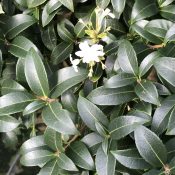
Photinia ‘Red Select’
Photinia x fraseri ‘Red Select’ is an evergreen shrub, similar to Photinia ‘Red Robin’ but more compact and with the new leaves emerging a deeper red colour. If planted in full sun, it produces rounded clusters of tiny white flowers in spring. A shrub with year-
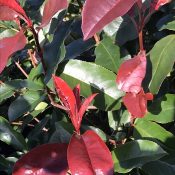
Photinia ‘Robusta Compacta’
This new variety of Photinia is in between the traditional Red Robin and the Little Red Robin. It has smaller leaves than the Red Robin but has an upright, tidier habit than Little Red Robin, which if left uncut tends to get a bit loose in nature. In the spring the new leaves and stems emerge as a deep red and then gradually fade through the season to green. If the shrub is regularly trimmed in late spring or summer it will make a very nice, dense, interesting evergreen hedge of up to 3 metres tall. Best planted in full sun or partial shade, bears white flowers in April to May.
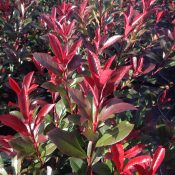
Pittosporum heterophyllum Variegatum
This form of the “Chinese pittosporum” is an evergreen shrub with small, white and green leaves and yellow fragrant flowers in spring and summer. It grows to 2.5 meters tall and prefers sun to partial shade and well-drained soil. It is attractive to bees and can be used as a hedge, a specimen, or a cut foliage for flower arrangements.
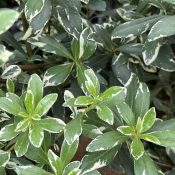
Pittosporum tenuifolium ‘Abbotsbury Gold’
Grown for their glossy evergreen foliage which is usually rounded or slightly oval and splashed golden. Used by flower arrangers, these excellent plants look great with palms and ferns, adding colour and contrast, but also as specimens in tubs. They trim beautifully into basic shapes and will grow in most soils except very wet. In cold areas shelter from strong winds, in coastal regions they make good hedges and wind breaks. Trim in spring and mid-
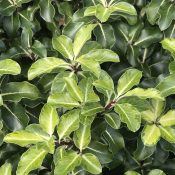
Pittosporum tenuifolium ‘Bannow Bay’
Pittosporum ‘Bannow Bay’ gives a different colour to the garden all year round. In spring and early summer, the young foliage is olive green with cream-white edges. In summer the colour changes to pink, cream-white and green, and in winter the leaves are pink with purple. The growth habit is compact, round and bushy. Grows slowly to 100cm best on well drained soil in sun or partial shade. Ideal for pruning into a low hedge.
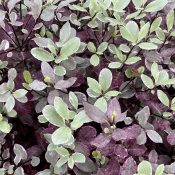
Pittosporum tenuifolium ‘Elizabeth’
Evergreen shrub with lovely variegated leaves of cream and green with a distinctive pink edge especially in winter. The tiny flowers are often fragrant and are followed by clusters of woody fruits. Excellent hedging and seaside shrub, foliage also useful for flower arranging. Unpruned, eventually making 3 meters
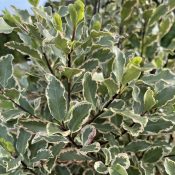
Pittosporum tenuifolium ‘Emerald Dome’
A compact, rounded evergreen shrub about 1-1.2 meters in height and spread, with dark young stems and small, dark green wavy-margined, glossy, leathery leaves. Small, honey-scented bell-shaped dark purple flowers are produced in clusters, from early summer.
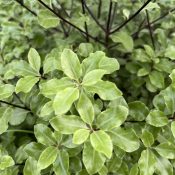
Pittosporum tenuifolium ‘Garnettii’
Useful evergreen, columnar or conical shrub of dense bushy habit. Rounded, grey-green leaves, irregularly edged with creamy-white, become tinged with deep pink in cold areas. May bear small, greenish-purple flowers in spring-summer. Requires full sun and well-drained soil. Grows to 3 meters.
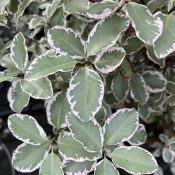
Pittosporum tenuifolium ‘Gold Star’
Evergreen compact shrub grown for its glossy evergreen foliage, wavy-edged leaves are splashed yellow and green. The tiny dark purple flowers in spring are fragrant. They trim beautifully into shapes and will grow in most soils, except very wet. In cold areas shelter from strong winds. In coastal regions they make good hedges and wind breaks.

Pittosporum tenuifolium ‘Golf Ball’
A useful, bushy evergreen shrub with distinct gold variegated and rounded leaves which remain particularly attractive throughout autumn and winter. Excellent hedging and seaside shrub.
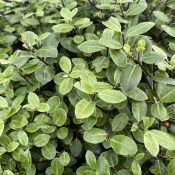
Pittosporum tenuifolium ‘Irene Paterson’
A striking small and slow evergreen shrub with white wavy-margined leaves, becoming dark green and white speckled and mottled. Purplish stems bear rounded tiny fragrant deep purple flowers from late spring. Grows to 1.5 meters tall or more making it excellent in flowerbeds or for training into a low hedge in moist but free-draining soil in sun or partial shade.
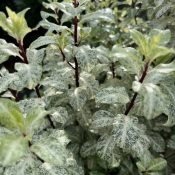
Pittosporum tenuifolium ‘Irish Luck’
Small upright shrub with glossy leaves, edged with fine silver hairs on the leaf margins. A fantastic variety for clipping and for hedges with its incredibly vigorous growth and neat, upright, dense growth habit. The inconspicuous, burgundy coloured flowers are lightly scented. Height 3 meters and spread 2 meters over 10 years. Grows best in well drained but moist soil in sun to partial shade but with shelter from the cold winds.
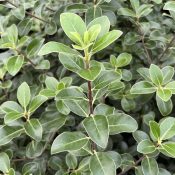
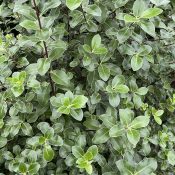
Pittosporum tenuifolium ‘Penmarch’
A mid-sized compact, rounded evergreen shrub with small grey-green wavy leaves and small purple-red flowers in summer. Height 2 meters.
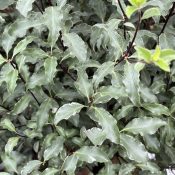
Pittosporum tenuifolium ‘Pompom’
A useful, dense and compact evergreen shrub of domed habit. Bright green glossy leaves contrast well against the dark stems; tiny purple scented flowers are borne in spring. An excellent variety for shaping, especially into balls. Untrimmed height and spread 1.2 meters but can be trained to any size or shape smaller than this. Best in moist but free-draining soil in sun or partial shade. Great for pots.
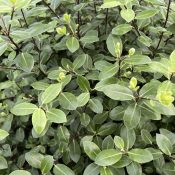
Pittosporum tenuifolium ‘Purpureum’
A large tree-like male plant with dark stems and oblong, undulating leaves opening pale green and changing from bronze to purple. The leaves are a good purple in deep shade but more mottled in strong light. It is said to have been found in Melbourne, Australia.
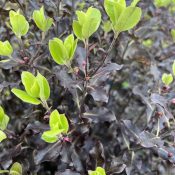
Pittosporum tenuifolium ‘Silver Ball’
A useful, dense and compact evergreen shrub that naturally forms a spherical shape. Grey-green leaves are decorated with irregular white margins. Fragrant, tiny purple scented flowers are borne in spring. Excellent variety for shaping and for low hedges. Untrimmed height and spread 1.2 meters but can be trained to any size or shape smaller than this. Best in moist but free-draining soil in sun or partial shade. Great for pots.
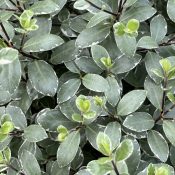
Pittosporum tenuifolium ‘Silver Magic’
An erect plant with black stems and small, almost flat, silvery-green leaves with pink tinged cream margins. Similar to ‘James Stirling’ in its erect habit but with more silvery-green leaves.
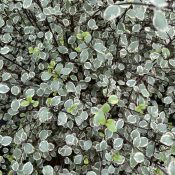
Pittosporum tenuifolium ‘Silver Sheen’
A reasonably fast growing, small leaved evergreen with beautiful silvery-green foliage. Ideal for formal hedging or screening, it responds well to pruning to maintain desired shape. Prefers a full sun to part shade position. Will tolerate light frost and requires little water once established.
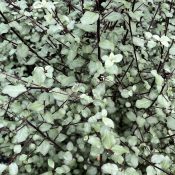
Pittosporum tenuifolium
This evergreen is a native of New Zealand, It makes an erect shrub with gloss wavy-
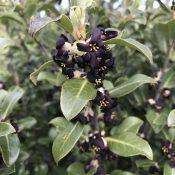
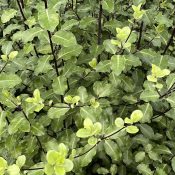
Pittosporum tenuifolium ‘Tom Thumb’
This dense, compact, evergreen shrub has a small, wavy, dark purple leaves contrasting with light green young growth and striking, dark grey or black young stems. With its distinctive rounded shape, it will give all-
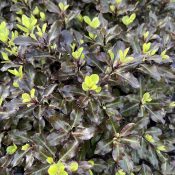
Pittosporum tenuifolium ‘Variegatum’
This bushy evergreen shrub has dramatic, dark grey or black young stems with wavy-variegated, grey-green leaves edged creamy-white. Makes a great feature for a sunny, well-drained border. An excellent plant for warm coastal areas, where it can successfully be grown as an attractive, variegated windbreak or hedge.
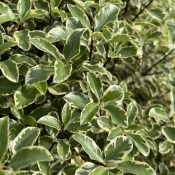
Pittosporum tenuifolium ‘Victoria’
A bushy evergreen shrub, native to New Zealand with ovate grey leaves margined white. Leaves become pinkish-purple in the winter contrasting with its black stems. Small fragrant black-purple flowers in the late spring and early summer. Eventual height up to 2 meters, prefers moist but free-draining soil in sun or partial shade.
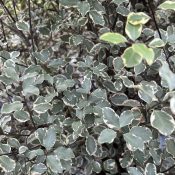
Prunus laurocerasus ‘Etna’
This fantastic dense evergreen Laurel makes an ideal hedge with darker green foliage than common laurel (Prunus laurocerasus ‘Rotundifolia’) and easily kept at 1.5 to 2 meters, it is more compact too. Excitingly, the new growth appears bronze-
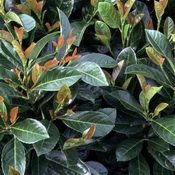
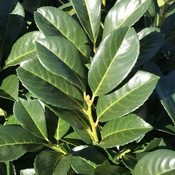
Prunus laurocerasus ‘Rotundifolia’
The “Common or Cherry Laurel” is a vigorous, dense evergreen shrub with large, glossy green leaves, which makes an ideal hedge. In spring, upright spikes of white flowers contrast well against the foliage, later in the year black cherry like fruit appear. The fast growth rate of 30 to 60cm per year makes it a very economical way to achieve a good height of evergreen hedge from 1.2m right up to 6m. It should be trimmed to shape in spring or autumn. Laurel is hardy and is very easy to grow, including in dense shade, but is not the most suitable choice for seaside gardens or very alkaline soil.
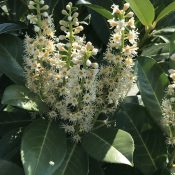
Prunus lusitanica ‘Angustifolia’
This form of “Portuguese Laurel” has dark green, pointed, glossy leaves on maroon stems and has a classical quality to it that makes it ideal for formal situations. Its fragrant white flower spikes attract bees and butterflies when they appear in summer and are followed by small red fruits which are loved by birds, which turn black in autumn. It is easy to grow in all soils and situations including dry shade and is a particularly good choice for chalk soils. Portuguese Laurel is very hardy but may suffer windburn if planted in coastal or very exposed situations. This cultivar has a medium growth rate so it is quite easy to maintain as a hedge or clip into shapes and should only need one trim per year in late summer. Will grow to 5 metres if left un-
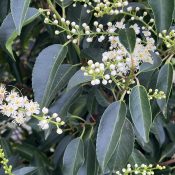
Quercus ilex
The originally Mediterranean “Holm Oak” or “Holly Oak” is a lush evergreen tree that will grow in any well drained soil and is equally happy growing right by the sea or in the middle of a city. Its dark-
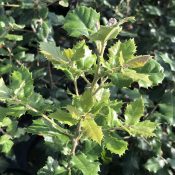
Taxus baccata
Our native “English Yew” is the classic conifer hedge plant for our climate, often referred to as King of Hedges. A dense, dark, evergreen species with bright green spring growth its autumnal red fruits are much loved by birds but harmful to humans, pets and livestock. Often thought to be very slow growing, it actually grows by 30cm a year, so not as slow as people think. Once it reaches its desired height (1 to 4 metres) it is easy to maintain with a cut in summer or early autumn. Yew plants needs plenty of water in the first couple of seasons but should not sit in waterlogged soil. If you are concerned that you have clay, wet soil, please improve the drainage when planting. Apart from its requirement for water, it is very easy to grow, shade tolerant, very hardy, and likes all soils.
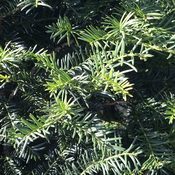
Thuja plicata ‘Atrovirens’
This form of “Western Red Cedar” (misleadingly not a cedar at all) is a coniferous evergreen which can be an excellent alternative to Cupressocyparis leylandii, where a large fast growing evergreen screen or barrier is required. It may be slightly slower growing but has the benefit of maintaining its density when harshly pruned and will re-shoot on hard pruned bare branches. Grows on any non-
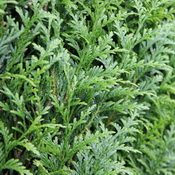
Thuja occidentalis ‘Brabant’
This form of “White Cedar” (misleadingly not a cedar at all) is a coniferous evergreen whose compact growth habit makes it ideal for hedging purposes but also forms a neatly shaped pyramidal specimen. Light, yellowish-
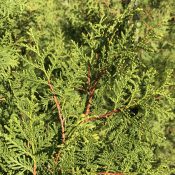
Trachelospermum jasminoides
An attractive woody, evergreen climber with rich, dark green leaves which turn bronze in winter. Clusters of highly fragrant, pure white flowers are produced from mid to late summer. It is best grown against a warm, sunny wall in milder areas or in a greenhouse or conservatory in areas prone to severe frosts.
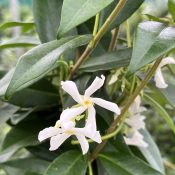
Viburnum tinus
“Laurustinus” is an excellent evergreen shrub that forms a dense informal hedge up to 3 to 4 metres tall with dark glossy green leaves and masses of white flowers from pink buds for a long period from October until April. The berries that follow are deep blue-
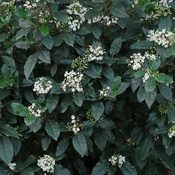
Viburnum tinus ‘Eve Price’
This popular form of “Laurustinus” is denser and more compact than the species. Flattened heads of pinkish-
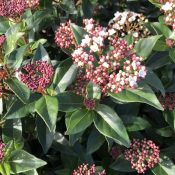
mrevergreen™
Efford Nursery,
Dell Buildings, Milford Rd,
Lymington,
Hampshire SO41 0ED
sales@mrevergreen.uk
01590-718300
Copyright © 2024 mrevergreen™![]()